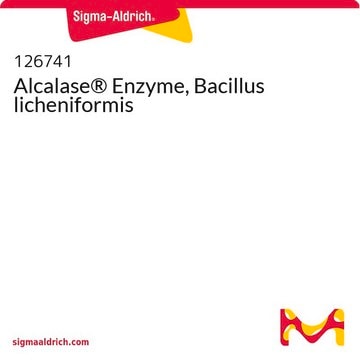V2010
Viscozyme® L
cellulolytic enzyme mixture
Sinónimos:
Cell Wall Degrading Enzyme Complex from Aspergillus sp., Lysing Enzyme from Aspergillus sp.
About This Item
Productos recomendados
origen biológico
fermentation/recombinant
Formulario
liquid
enzyme activity
≥100 FBGU/g
técnicas
protein extraction: suitable
densidad
~1.2 g/mL at 25 °C (lit.)
idoneidad
suitable for cell lysis
aplicaciones
cell analysis
temp. de almacenamiento
2-8°C
Descripción general
Aplicación
- in the extraction of polyphenol from grapefruit and unripe apples.
- to study the effect of its supplementation on nutritive value and silage characteristics of sunflower silage.
- for simulation of the fermentation process during in vitro digestibility of former food products (FFPs).
- for enzymatic treatment, to study its effects on the antioxidant properties of wheat bran.
Acciones bioquímicas o fisiológicas
Características y beneficios
- Not a GMO and doesn′t contain GMOs.
- Made by fermentation of a microorganism.
- Improves process through faster, more efficient oil/water separation.
Información legal
Palabra de señalización
Danger
Frases de peligro
Consejos de prudencia
Clasificaciones de peligro
Resp. Sens. 1
Código de clase de almacenamiento
10 - Combustible liquids
Clase de riesgo para el agua (WGK)
WGK 1
Punto de inflamabilidad (°F)
Not applicable
Punto de inflamabilidad (°C)
Not applicable
Equipo de protección personal
Eyeshields, Gloves, multi-purpose combination respirator cartridge (US)
Elija entre una de las versiones más recientes:
Certificados de análisis (COA)
¿No ve la versión correcta?
Si necesita una versión concreta, puede buscar un certificado específico por el número de lote.
¿Ya tiene este producto?
Encuentre la documentación para los productos que ha comprado recientemente en la Biblioteca de documentos.
Los clientes también vieron
Nuestro equipo de científicos tiene experiencia en todas las áreas de investigación: Ciencias de la vida, Ciencia de los materiales, Síntesis química, Cromatografía, Analítica y muchas otras.
Póngase en contacto con el Servicio técnico










